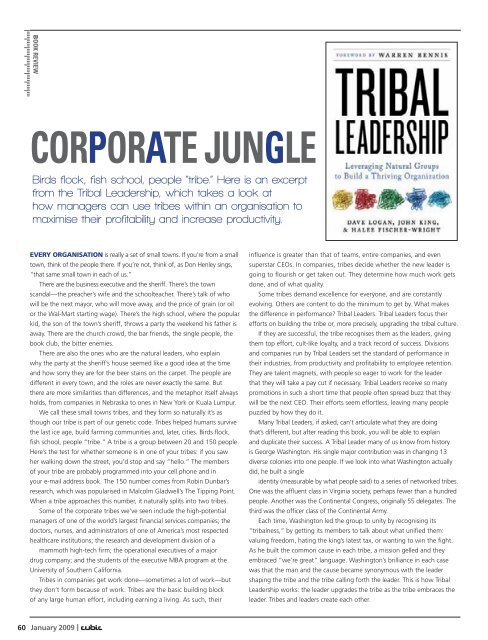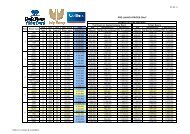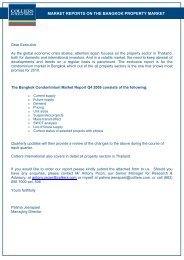CUBIC CoverDec08.indd - Colliers
CUBIC CoverDec08.indd - Colliers
CUBIC CoverDec08.indd - Colliers
You also want an ePaper? Increase the reach of your titles
YUMPU automatically turns print PDFs into web optimized ePapers that Google loves.
BOOK REVIEW<br />
CORPORATE JUNGLE<br />
Birds flock, fish school, people “tribe.” Here is an excerpt<br />
from the Tribal Leadership, which takes a look at<br />
how managers can use tribes within an organisation to<br />
maximise their profitability and increase productivity.<br />
EVERY ORGANISATION is really a set of small towns. If you’re from a small<br />
town, think of the people there. If you’re not, think of, as Don Henley sings,<br />
“that same small town in each of us.”<br />
There are the business executive and the sheriff. There’s the town<br />
scandal—the preacher’s wife and the schoolteacher. There’s talk of who<br />
will be the next mayor, who will move away, and the price of grain (or oil<br />
or the Wal-Mart starting wage). There’s the high school, where the popular<br />
kid, the son of the town’s sheriff, throws a party the weekend his father is<br />
away. There are the church crowd, the bar friends, the single people, the<br />
book club, the bitter enemies.<br />
There are also the ones who are the natural leaders, who explain<br />
why the party at the sheriff’s house seemed like a good idea at the time<br />
and how sorry they are for the beer stains on the carpet. The people are<br />
different in every town, and the roles are never exactly the same. But<br />
there are more similarities than differences, and the metaphor itself always<br />
holds, from companies in Nebraska to ones in New York or Kuala Lumpur.<br />
We call these small towns tribes, and they form so naturally it’s as<br />
though our tribe is part of our genetic code. Tribes helped humans survive<br />
the last ice age, build farming communities and, later, cities. Birds flock,<br />
fish school, people “tribe.” A tribe is a group between 20 and 150 people.<br />
Here’s the test for whether someone is in one of your tribes: if you saw<br />
her walking down the street, you’d stop and say “hello.” The members<br />
of your tribe are probably programmed into your cell phone and in<br />
your e-mail address book. The 150 number comes from Robin Dunbar’s<br />
research, which was popularised in Malcolm Gladwell’s The Tipping Point.<br />
When a tribe approaches this number, it naturally splits into two tribes.<br />
Some of the corporate tribes we’ve seen include the high-potential<br />
managers of one of the world’s largest financial services companies; the<br />
doctors, nurses, and administrators of one of America’s most respected<br />
healthcare institutions; the research and development division of a<br />
mammoth high-tech firm; the operational executives of a major<br />
drug company; and the students of the executive MBA program at the<br />
University of Southern California.<br />
Tribes in companies get work done—sometimes a lot of work—but<br />
they don’t form because of work. Tribes are the basic building block<br />
of any large human effort, including earning a living. As such, their<br />
influence is greater than that of teams, entire companies, and even<br />
superstar CEOs. In companies, tribes decide whether the new leader is<br />
going to flourish or get taken out. They determine how much work gets<br />
done, and of what quality.<br />
Some tribes demand excellence for everyone, and are constantly<br />
evolving. Others are content to do the minimum to get by. What makes<br />
the difference in performance? Tribal Leaders. Tribal Leaders focus their<br />
efforts on building the tribe or, more precisely, upgrading the tribal culture.<br />
If they are successful, the tribe recognises them as the leaders, giving<br />
them top effort, cult-like loyalty, and a track record of success. Divisions<br />
and companies run by Tribal Leaders set the standard of performance in<br />
their industries, from productivity and profitability to employee retention.<br />
They are talent magnets, with people so eager to work for the leader<br />
that they will take a pay cut if necessary. Tribal Leaders receive so many<br />
promotions in such a short time that people often spread buzz that they<br />
will be the next CEO. Their efforts seem effortless, leaving many people<br />
puzzled by how they do it.<br />
Many Tribal Leaders, if asked, can’t articulate what they are doing<br />
that’s different, but after reading this book, you will be able to explain<br />
and duplicate their success. A Tribal Leader many of us know from history<br />
is George Washington. His single major contribution was in changing 13<br />
diverse colonies into one people. If we look into what Washington actually<br />
did, he built a single<br />
identity (measurable by what people said) to a series of networked tribes.<br />
One was the affluent class in Virginia society, perhaps fewer than a hundred<br />
people. Another was the Continental Congress, originally 55 delegates. The<br />
third was the officer class of the Continental Army.<br />
Each time, Washington led the group to unity by recognising its<br />
“tribalness,” by getting its members to talk about what unified them:<br />
valuing freedom, hating the king’s latest tax, or wanting to win the fight.<br />
As he built the common cause in each tribe, a mission gelled and they<br />
embraced “we’re great” language. Washington’s brilliance in each case<br />
was that the man and the cause became synonymous with the leader<br />
shaping the tribe and the tribe calling forth the leader. This is how Tribal<br />
Leadership works: the leader upgrades the tribe as the tribe embraces the<br />
leader. Tribes and leaders create each other.<br />
60 January November 2009 2008 | |













